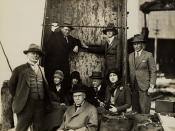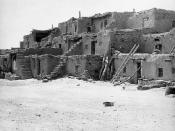Evaluations for the Oraibi Split
The split of the Third Mesa pueblo, Oraibi, occurred on September 7, 1906. The split immediately changed the lives of roughly 800 inhabitants of Oraibi who represented nearly half of the Hopi population. Those who left Oraibi were forced to start their lives over in a new location. From a long-term perspective, the split is consequential because it led to the establishment of other villages (e.g., Bacavi, Hotevilla, and Kykotsmovi) of Third Mesa that did not exist before the division (Waters 1977: 113). This eventually resulted in different versions of Hopi history and the Oraibi split from each village. Anthropologists have offered many different explanations of the Oraibi fissioning. These various proposals have caused the interpretation and understanding of the division of Oraibi to be very complex. This essay evaluates explanations of four different anthropologists: Mischa Titiev, Richard Bradfield, Richard Clemmer, and Peter Whiteley.
Titiev provides the first explanation to consider. Taking all of Titiev's arguments together, he suggests that internal social structure pressures and instabilities led to the disintegration of the Oraibi pueblo (Titiev 1992: 48). Titiev's analysis of Oraibi disintegration is based on his view of Hopi social structure and social integration. For Titiev, three features of the traditional social structure of Hopi villages, including Oraibi, were essential.
The first feature was the organization of Hopi matrilineal descent groups into households, lineages, clans, and phratries (Titiev 1992:51). In Titiev's view, Hopi clans were basically autonomous and corporate, owning land, rituals, and kivas. The second feature was the organization of religious societies and kiva groups. The chief priests of religious sodalities were drawn from the descent group that "owned" a particular religious ceremony (Page 1994: 47). These ceremonies were controlled by a particular descent group, the matrilineal clan. Common membership in...


